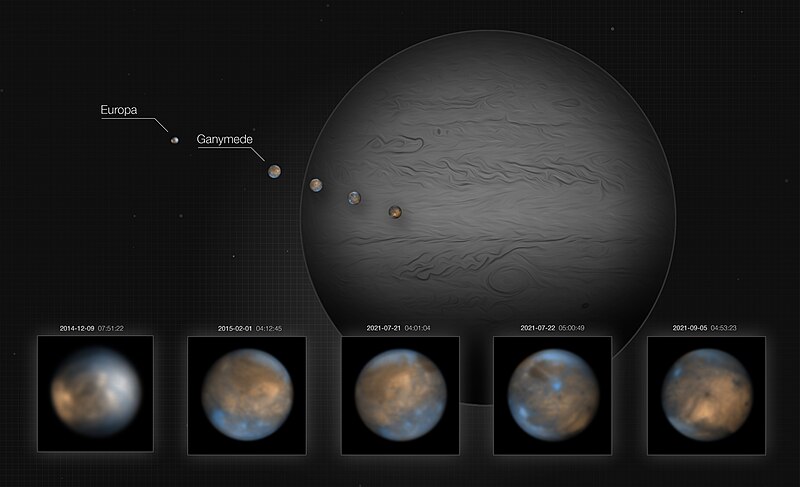File:The icy moons of Jupiter (potw2241a).jpg

Original file (6,750 × 4,108 pixels, file size: 1.45 MB, MIME type: image/jpeg)
Captions
Captions
Summary[edit]
| DescriptionThe icy moons of Jupiter (potw2241a).jpg |
English: This Picture of the Week shows two of Jupiter’s moons, the icy Ganymede and Europa, which have been imaged in the infrared using the SPHERE instrument on ESO’s Very Large Telescope. Whilst Europa is quite similar in size to our own Moon, Ganymede is the largest moon in the whole Solar System – it’s even bigger than the planet Mercury! Their orbits around Jupiter are slightly elliptical, so they get closer and further away from the planet as they orbit it. This results in the moons being stretched and squeezed by the gravitational pull from Jupiter at periodical intervals. This creates frictional heat, warming the insides of the moons, which has made them geologically active. Europa in particular is likely to have active plumes and geysers erupting from the oceans of liquid water beneath the thick ice cover that makes up the surface. Estimates on the abundances of chemical species on the marble-like surfaces of these moons could be made thanks to these new images and also spectra, which have been published in two studies by Oliver King and Leigh N. Fletcher at the University of Leicester in the United Kingdom. They found that the bright regions of Ganymede consist mainly of water in the form of ice with hints of various salts, and that they have formed more recently than the older darker patches, whose composition still remains a mystery to astronomers.Observing these moons with ground-based telescopes is challenging, because they look as small as a 1 Euro coin seen from 3-5 km away. Earth’s atmosphere would completely blur these images, but SPHERE’s adaptive optics system corrects these distortions, delivering very sharp images with details as small as 150 km. |
||
| Date | 10 October 2022 (upload date) | ||
| Source |
|
||
| Author | ESO/King & Fletcher. Jupiter background image: NASA, ESA, A. Simon (Goddard Space Flight Center), and M. H. Wong (University of California, Berkeley) and the OPAL team. | ||
| Other versions |
|
Licensing[edit]
 |
This media was created by the European Southern Observatory (ESO).
Their website states: "Unless specifically noted, the images, videos, and music distributed on the public ESO website, along with the texts of press releases, announcements, pictures of the week, blog posts and captions, are licensed under a Creative Commons Attribution 4.0 International License, and may on a non-exclusive basis be reproduced without fee provided the credit is clear and visible." To the uploader: You must provide a link (URL) to the original file and the authorship information if available. |
This file is licensed under the Creative Commons Attribution 4.0 International license.
| |
File history
Click on a date/time to view the file as it appeared at that time.
| Date/Time | Thumbnail | Dimensions | User | Comment | |
|---|---|---|---|---|---|
| current | 11:03, 1 July 2023 |  | 6,750 × 4,108 (1.45 MB) | OptimusPrimeBot (talk | contribs) | #Spacemedia - Upload of https://cdn.eso.org/images/large/potw2241a.jpg via Commons:Spacemedia |
You cannot overwrite this file.
File usage on Commons
The following page uses this file:
Metadata
This file contains additional information such as Exif metadata which may have been added by the digital camera, scanner, or software program used to create or digitize it. If the file has been modified from its original state, some details such as the timestamp may not fully reflect those of the original file. The timestamp is only as accurate as the clock in the camera, and it may be completely wrong.
| Credit/Provider | ESO/King & Fletcher. Jupiter background image: NASA, ESA, A. Simon (Goddard Space Flight Center), and M. H. Wong (University of California, Berkeley) and the OPAL team. |
|---|---|
| Source | European Southern Observatory |
| Short title |
|
| Image title |
|
| Usage terms |
|
| Date and time of data generation | 06:00, 10 October 2022 |
| Software used | Adobe Photoshop 23.5 (Windows) |
| File change date and time | 14:43, 28 September 2022 |
| Date metadata was last modified | 16:43, 28 September 2022 |
| Date and time of digitizing | 17:36, 21 September 2022 |
| Unique ID of original document | xmp.did:5fccd8ea-cad9-0e4b-8ed4-ff97796122a2 |
| Keywords |
|
| Contact information |
Karl-Schwarzschild-Strasse 2 Garching bei München, None, D-85748 Germany |
| IIM version | 4 |
